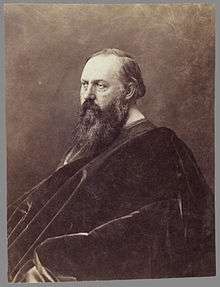Prince Leopold, Count of Syracuse
| Prince Leopold | |||||
|---|---|---|---|---|---|
| Count of Syracuse | |||||
 Leopold, Count of Syracuse by Nadar | |||||
| Born |
22 May 1813 Palermo | ||||
| Died |
4 December 1860 (aged 47) Pisa | ||||
| Burial | Basilica of Santa Chiara, Naples | ||||
| Spouse | Maria of Savoy | ||||
| Issue | Princess Maria Isabella | ||||
| |||||
| House | Bourbon-Two Sicilies | ||||
| Father | Francis I of the Two Sicilies | ||||
| Mother | Maria Isabella of Spain | ||||
Prince Leopold of the Two Sicilies[1] (22 May 1813, Palermo[1] – 4 December 1860, Pisa[1]) was a prince of the Two Sicilies and was known as the Count of Syracuse.
Life
%2C_Neapolitan_school%2C_Circa_1825.jpg)
Leopold was the fifth son of Francis I of the Two Sicilies and his second wife, Maria Isabella of Spain.[1] In 1816, at the creation of the kingdom of the Two Sicilies, when he was three years old, he was given the title of Count of Syracuse.
At his father's death in November 1830, Leopold's elder brother, Ferdinand II of the Two Sicilies, named him Lieutenant general in Sicily.[2] As governor in Palermo, he introduced important reforms.[3] Fearing his popularity and the desire of Sicily for independence, he was recalled from his position in early 1835.[4] In April of the same year, he was sent to travel abroad.[4]
Ferdinand II considered a marriage between Leopold and his cousin Princess Marie of Orléans, but the negotiations with her father, Louis-Philippe of France, foundered over the French uprisings in 1834 and Louis-Philippe's refusal to grant Marie her part of the "donation-partage" of his lands (a condition Ferdinand had put in place for the marriage to occur). Leopold was an artist, a skillful sculptor and patron of the arts. He lacked great ambition, preferring to lead a life of pleasure.[5]
Leopold married Princess Maria of Savoy, second-eldest daughter of Prince Joseph Maria of Savoy, Count of Villafranca, and his wife Pauline Benedictine de Quélen de Vauguyon, on 16 June 1837[1] in Naples. They were ill matched and their marriage was unhappy. He was an agnostic and liberal. She was a conservative religious fanatic, with nothing in common with him. They managed to have only one child, Maria Isabella, who died less than a year after her birth in 1838.[1] From them on they lived separate lives. She retired to live a religious life in almost seclusion at her palace of Chiaia.[5]
The Count of Syracuse lived abroad between 1846 and 1850.[6] In spite of his opposed political tendencies, he was Ferdinand II's favorite brother. When he suffered a stroke in 1854, the king was deeply distressed.[6] The Count recovered. Like his brothers, the counts of Aquila and Trapani, he was a womanizer, but he was not involved in scandals and his brother the King paid his debts regarding him as a lovable black sheep.[7] He was an hedonistic man described as "large, powerful, with a handsome countenance"[7] Simple in his manners, he was widely popular.[7] He surrounded himself with a court of artists, writers and musicians, who followed him from his palace on the Chiaia to his villa at Sorrento.[7]
After the death of Ferdinand II in May 1859, the Count of Syracuse advocated a close alliance with Piedmont.[8] He had a low opinion of his nephew, Francis II, the new king. Their relationship was cold.[9][10] In April 1860, Leopold urged his nephew Francis II to make liberal concessions.[11] After few months, he went to Piedmont. He died shortly after in Pisa.
Titles, styles, honours and arms
.svg.png)
Titles and styles
- 22 May 1813 – 12 December 1816 His Royal Highness The Most Serene Prince Don Leopoldo
- 12 December 1816 - 4 December 1860: His Royal HighnessThe Most Serene Prince Don Leopoldo, Count of Syracuse
Honours
- Knight of the Orders of the King of France (1826)
- Knight of the Order of Saint Januarius (1813)
- Knight of the Spanish Order of the Golden Fleece (1813)
- Knight Grand Cross of the Order of Saint Ferdinand and of Merit
- Knight Grand Cross with Collar of the Order of Charles III
- Knight of the Order of the Black Eagle
- Knight of the Order of the Most Holy Annunciation
Ancestry
| Ancestors of Prince Leopold, Count of Syracuse | ||||||||||||||||||||||||||||||||||||||||||||||||||||||||||||||||||||||||||||||||||||||||||||||||||||||||||||||||||||||||||||||||||||||||||||||||||||||||||||||||||||||||||||||||||||||||||||||||||||||||||||||||||||||||||||||||||||||||||||||||||||||||||||||||||||||||||||||||||||||||||||||||||||||||||||||||||||||||||||||||||||||||||||||||||||||||||||||||||||||||||||||||||||||||||||||||||||||||||||||||||||||||||||||||||||||||||||||||||||||||||||||||||||||||||||||||||||||||||||||||||||||||||||||||||||||||||||||||||
|---|---|---|---|---|---|---|---|---|---|---|---|---|---|---|---|---|---|---|---|---|---|---|---|---|---|---|---|---|---|---|---|---|---|---|---|---|---|---|---|---|---|---|---|---|---|---|---|---|---|---|---|---|---|---|---|---|---|---|---|---|---|---|---|---|---|---|---|---|---|---|---|---|---|---|---|---|---|---|---|---|---|---|---|---|---|---|---|---|---|---|---|---|---|---|---|---|---|---|---|---|---|---|---|---|---|---|---|---|---|---|---|---|---|---|---|---|---|---|---|---|---|---|---|---|---|---|---|---|---|---|---|---|---|---|---|---|---|---|---|---|---|---|---|---|---|---|---|---|---|---|---|---|---|---|---|---|---|---|---|---|---|---|---|---|---|---|---|---|---|---|---|---|---|---|---|---|---|---|---|---|---|---|---|---|---|---|---|---|---|---|---|---|---|---|---|---|---|---|---|---|---|---|---|---|---|---|---|---|---|---|---|---|---|---|---|---|---|---|---|---|---|---|---|---|---|---|---|---|---|---|---|---|---|---|---|---|---|---|---|---|---|---|---|---|---|---|---|---|---|---|---|---|---|---|---|---|---|---|---|---|---|---|---|---|---|---|---|---|---|---|---|---|---|---|---|---|---|---|---|---|---|---|---|---|---|---|---|---|---|---|---|---|---|---|---|---|---|---|---|---|---|---|---|---|---|---|---|---|---|---|---|---|---|---|---|---|---|---|---|---|---|---|---|---|---|---|---|---|---|---|---|---|---|---|---|---|---|---|---|---|---|---|---|---|---|---|---|---|---|---|---|---|---|---|---|---|---|---|---|---|---|---|---|---|---|---|---|---|---|---|---|---|---|---|---|---|---|---|---|---|---|---|---|---|---|---|---|---|---|---|---|---|---|---|---|---|---|---|---|---|---|---|---|---|---|---|---|---|---|---|---|---|---|---|---|---|---|---|---|---|---|---|---|---|---|---|---|---|---|---|---|---|---|---|---|---|---|---|---|---|---|---|---|---|---|---|---|---|---|---|---|---|---|---|---|---|---|---|---|---|---|---|---|---|---|---|---|---|---|---|---|---|---|---|---|---|---|---|---|---|---|---|---|---|---|---|---|---|---|---|---|---|---|---|---|---|---|---|---|---|---|---|---|---|---|---|---|---|---|---|---|---|---|---|
| ||||||||||||||||||||||||||||||||||||||||||||||||||||||||||||||||||||||||||||||||||||||||||||||||||||||||||||||||||||||||||||||||||||||||||||||||||||||||||||||||||||||||||||||||||||||||||||||||||||||||||||||||||||||||||||||||||||||||||||||||||||||||||||||||||||||||||||||||||||||||||||||||||||||||||||||||||||||||||||||||||||||||||||||||||||||||||||||||||||||||||||||||||||||||||||||||||||||||||||||||||||||||||||||||||||||||||||||||||||||||||||||||||||||||||||||||||||||||||||||||||||||||||||||||||||||||||||||||||
Notes
- 1 2 3 4 5 6 Lundy, Darryl (23 May 2003). "Leopoldo di Borbone, Principe di Borbone delle Due Sicilie". the Peerage]. Retrieved 2008-10-02.
- ↑ Acton, The Last Bourbons of Naples, p. 48
- ↑ Acton, The Last Bourbons of Naples, p. 78
- 1 2 Acton, The Last Bourbons of Naples, p. 79
- 1 2 Acton, The Last Bourbons of Naples, p. 82
- 1 2 Acton, The Last Bourbons of Naples, p. 342
- 1 2 3 4 Acton, The Last Bourbons of Naples, p. 343
- ↑ Acton, The Last Bourbons of Naples, p. 388
- ↑ Acton, The Last Bourbons of Naples, p. 407
- ↑ Acton, The Last Bourbons of Naples, p. 469
- ↑ Acton, The Last Bourbons of Naples, p. 471
References
- Acton, Harold. The Last Bourbons of Naples (1825-1861). St Martin's Press. London, 1961. ASIN: B0007DKBAO
External links
- Lundy, Darryl. "Leopold". The Peerage.